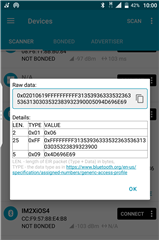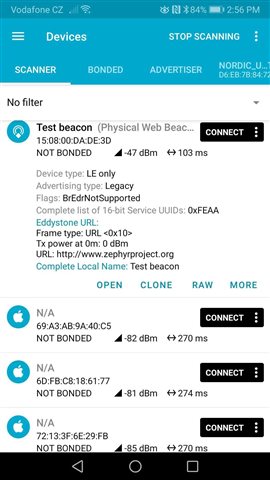Hello,
We just noticed that according to the Raw data detail in nRF Connect, we are able to advertise more than 31B data limit. Is that possible or do we incorrectly count the bytes in the advertising payload? This is a way how we do it:
length+ type + payload = xB
1 + 1 + 1 = 3B Flags
1 + 1 + 24 = 26B Manufacturer-specific data
1 + 1 + 4 = 6B Short name
Comes out to 35B in total and shouldn't be valid. However, it seems to be working, see screenshot below.

We are using nRF52833 and 1.3.1 NCS. Relevant code is:
void dt_bt_conn_adv_start_handler() {
uint8_t manufDataBuff[]={0xFF, 0xFF, 0xFF, 0xFF, 0x00, 0x00, 0x00, 0x00,
0x00, 0x00, 0x00, 0x00, 0x00, 0x00, 0x00, 0x00,
0x00, 0x00, 0x00, 0x00, 0x00, 0x00, 0x00, 0x00};
memcpy(manufDataBuff+4, odid_basic_data.UASID, sizeof(manufDataBuff)-4);
struct bt_data dt_bt_conn_ad[] = {
BT_DATA_BYTES(BT_DATA_FLAGS, (BT_LE_AD_GENERAL | BT_LE_AD_NO_BREDR)),
{
.type = BT_DATA_MANUFACTURER_DATA,
.data_len = sizeof(manufDataBuff),
.data = manufDataBuff,
}
};
int res = bt_le_adv_start(BT_LE_ADV_CONN_NAME, dt_bt_conn_ad, ARRAY_SIZE(dt_bt_conn_ad), NULL, 0);
if(res == -EAGAIN) {
LOG_INF("Start failed with EAGAIN. Delaying start");
k_delayed_work_submit_to_queue(&dt_bt_work_q, &dt_bt_conn_adv_start_work, K_MSEC(500));
return;
}
if (res) {
LOG_ERR("Advertising failed to start (err %d)\n", res);
return;
}
LOG_INF("Advertising connactable started");
return;
}


